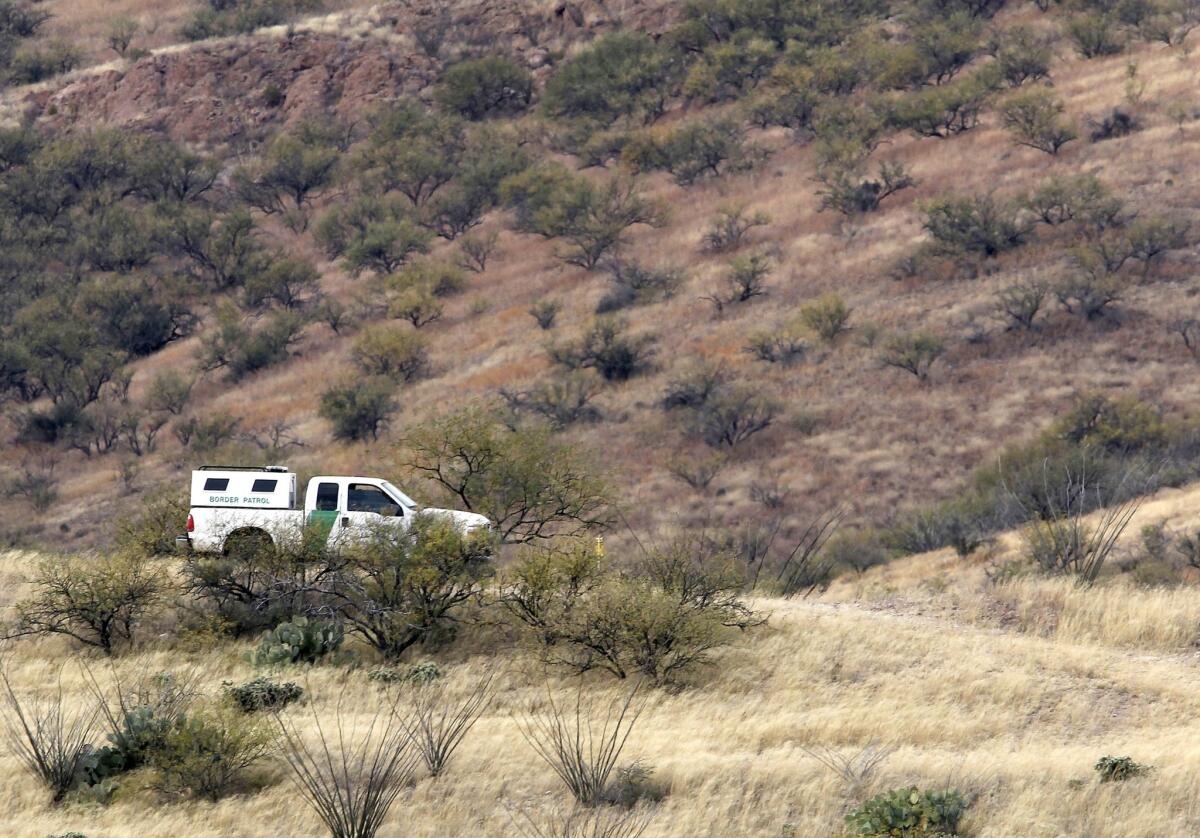Suspect in border agent Brian Terry’s death extradited from Mexico

- Share via
Reporting from TUCSON — It was a bloody confrontation more than three years ago in the desert brush of Arizona about 11 miles from the border with Mexico. When it was over, U.S. Border Patrol Agent Brian A. Terry was dead and two weapons found at the scene would shine a light on a botched gun-tracking operation known as Fast and Furious that became a political headache for the Obama administration.
On Wednesday, one of the five men accused of murder in the case was returned to the United States from Mexico, where he was arrested almost two years ago. Lionel Portillo-Meza, also known as Jesus Leonel Sanchez-Meza, appeared in federal court, where he entered a plea of not guilty and was ordered held without bail.
“We have been anticipating this extradition and we are very pleased,” said Robert Heyer, Brian Terry’s cousin and chairman of the Brian Terry Foundation.
“It’s been a long time,” Heyer said. “You know, he’s been sitting in jail in Mexico for almost two years. It took a long time for him to be extradited. But we’re very, very thankful that the Mexican government has continued to show cooperation and pursuit of justice of the murder of Border Patrol Agent Brian Terry.”
Another suspect, Ivan Soto-Barraza, has been in custody in Mexico awaiting extradition since 2013. Two men, Jesus Rosario Favela-Astorga and Heraclio “Laco” Osorio-Arellanes, remain at large. A reward of $250,000 has been offered for each.
Manuel Osorio-Arellanes, who was shot and apprehended the night of the confrontation, is serving a 30-year sentence after pleading guilty to first-degree murder.
The shooting of a federal agent along the U.S.-Mexico border, where immigrants, drugs and guns are a constant concern, would have been notorious in its own right. But the case eventually cast a spotlight on Fast and Furious, the program that was supposed to track and eventually stop illegal guns from being funneled into Mexico.
More than just embarrassment was at stake. Terry’s killing unraveled the Justice Department-sanctioned gun-tracking operation and triggered one of the biggest political controversies of President Obama’s first term.
The scandal drove out the head of the federal Bureau of Alcohol, Tobacco, Firearms and Explosives and left Atty. Gen. Eric H. Holder Jr. in contempt of Congress for refusing to turn over records. It became a GOP buzzword, as potent in some circles as “Benghazi” is now.
“This marks a major step forward in our aggressive pursuit of those responsible for the murder of Agent Brian Terry, who made the ultimate service while serving his country,” Holder said of Wednesday’s extradition.
“By securing the extradition of this suspect, the Department of Justice has ensured that he will stand trial and face justice here in the United States,” Holder said. “And we will never waver in our commitment to ensure that those who commit acts of violence against our best and bravest can be caught and held accountable – to the fullest extent of the law.”
It was shortly after 11 p.m. on Dec. 14, 2010, when Terry, 40, died in the shootout near Rio Rico.
He and three other Border Patrol agents were on duty in a section of Peck Canyon when they encountered a heavily armed five-man team of Mexican bandits who had sneaked across the border, picked up some weapons and were headed to rob marijuana dealers. Their illegal operation was known as a “rip-crew.”
According to court papers, one of the agents shouted “Police!” in English and Spanish, and the shooting began. Terry was fatally wounded by a single bullet during the exchange and Osorio-Arellanes, of El Fuerte, in the Mexican state of Sinaloa, was shot in the torso. The other Mexicans fled back across the border.
Two guns found at the scene were eventually traced to a member of a gun-smuggling ring that was being monitored in the Fast and Furious investigation. U.S. authorities have been criticized for allowing informants to walk away from Phoenix-area gun shops with weapons rather than immediately arresting them.
As the furor expanded, so did the fallout.
In addition to the political problem of the House of Representatives holding a sitting attorney general in contempt, prosecutors in Arizona were recused from the Terry murder case, which was taken over by the U.S. attorney’s office for the Southern District of California. The Arizona officials had been involved in Fast and Furious.
Carcamo reported from Tucson and Serrano from Washington. Times staff writer Michael Muskal in Los Angeles contributed to this report.
More to Read
Sign up for Essential California
The most important California stories and recommendations in your inbox every morning.
You may occasionally receive promotional content from the Los Angeles Times.












